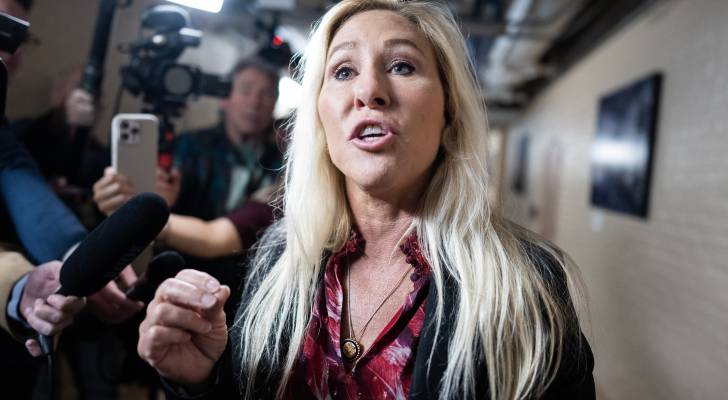
More than nine months into his second term, President Donald Trump is struggling to deliver on a key campaign promise: making life more affordable.
That’s not criticism from a political adversary but an admission from a fellow Republican, Rep. Marjorie Taylor Greene.
Must Read
- Thanks to Jeff Bezos, you can now become a landlord for as little as $100 — and no, you don’t have to deal with tenants or fix freezers. Here’s how
- Robert Kiyosaki says this 1 asset will surge 400% in a year — and he begs investors not to miss its ‘explosion’
- Dave Ramsey warns nearly 50% of Americans are making 1 big Social Security mistake — here’s what it is and 3 simple steps to fix it ASAP
"Prices have not come down at all,” Greene said on the The Tim Dillon Show. (1) “The job market is extremely difficult. Wages have not gone up. Health insurance is going up. Home insurance goes up. Rent is going up. Young people have no hope of buying a home."
There’s data to back up many of her concerns. In fact, some key affordability metrics show the situation may be worsening rather than improving or even stabilizing. Here’s a closer look at the persistent squeeze that many Americans, particularly younger ones, face.
Affordability crisis
Ordinary Americans continue to face a persistent affordability crisis. As of August, the consumer price index rose 2.9% over the past 12 months, according to the U.S. Bureau of Labor Statistics (BLS). (2) That means prices are going up faster than the Federal Reserve’s 2% target. (3)
Trump’s ongoing and volatile trade war has added another layer. As of October, consumers face an average effective tariff rate of 18%, according to the Yale Budget Lab. (4) Goldman Sachs analysis suggests businesses are currently absorbing much of this cost, but consumers could eventually shoulder 67% of tariff costs over time. (5)
Meanwhile, rent and mortgage payments are going up faster than inflation. In August, housing costs rose 3.6% over the past 12 months, BLS date shows. As of mid-2025, house price-to-income ratio is at an all-time high, and Americans need an income of $104,000 at least to afford a median-priced home, according to CBRE. (6)
In the midst of rising prices, wages are barely keeping up. The Atlanta Federal Reserve tracker found that three-month rolling wage growth in August 2025 was 4.1% — well below the 6.7% growth recorded in August 2022 under the Joe Biden administration. (7)
Feeling the squeeze, many consumers are preparing to tighten their belts. About 83% of adults said they will strongly consider slashing their budget for non-essential items in the months ahead because of ongoing trade tensions, according to a survey by Intuit Credit Karma. (8) Younger Americans, including Gen Z and millennials, were the most likely to say so.
Still, a tighter budget isn’t the only way to mitigate the impact of this affordability crisis.
Read more: I’m almost 50 and have nothing saved for retirement — what now? Don’t panic. These 6 easy steps can help you turn things around
How to prepare
Reworking your monthly and annual budget is the most conventional way to handle a cost-of-living crunch. But cutting non-essential spending alone may not be enough to navigate today’s economy.
To strengthen your finances, consider building a more robust emergency fund. The median emergency savings balance in the U.S. is about $500, and one in three Americans say they have no emergency savings at all, according to Empower. (9) In this economy, that’s a risky position. Aim to set aside at least three months’ worth of living expenses in a separate emergency fund.
You could also add a new stream of income, such as freelancing or gig work. More than half of Americans — 51% — say they’ve taken on a side hustle to deal with higher living costs, according to a MarketWatch Guides survey. (10)
Finally, adding inflation-resistant assets to your portfolio could help protect your nest egg over the long run. Financial experts who spoke to CNBC recently recommended gold, real estate, commodities and Treasury Inflation-Protected Securities (TIPS) to help ordinary consumers outmaneuver rising inflation. (11)
Combining these money-saving and income-building strategies could leave you in a much stronger position to weather the affordability crunch.
What to read next
- Dave Ramsey says this 7-step plan ‘works every single time’ to kill debt, get rich — and ‘anyone’ can do it
- Are you richer than you think? 5 clear signs you’re punching way above the average American’s wealth
- Warren Buffett used 8 simple money rules to turn $9,800 into a stunning $150B — start using them today to get rich (and then stay rich)
- This tiny hot Costco item has skyrocketed 74% in price in under 2 years — but now the retail giant is restricting purchase. Here’s how to buy the coveted asset in bulk
Join 200,000+ readers and get Moneywise’s best stories and exclusive interviews first — clear insights curated and delivered weekly. Subscribe now.
Article sources
We rely only on vetted sources and credible third-party reporting. For details, see our editorial ethics and guidelines.
Independent (1); U.S. Bureau of Labor Statistics (2); Federal Reserve (3); Yale Budget Lab (4); NBC News (5); CBRE (6); Atlanta Federal Reserve (7); Intuit Credit Karma (8); Empower (9); Marketwatch (10); CNBC (11).
This article originally appeared on Moneywise.com under the title: MTG admits prices under Trump ‘have not come down at all,’ says young Americans have ‘no hope’ of buying homes
This article provides information only and should not be construed as advice. It is provided without warranty of any kind.